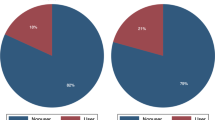Abstract
There have been changes in the national policy regarding population growth in Malaysia from 1982. This report studies the changes in contraceptive practice among the three racial groups in this country, i.e. Malays, Chinese and Indians, over a 5-year period with an interval of 10 years. This is a retrospective study based on the attendance at the same family planning clinic in an urban setting. The striking change noted is the change in the racial composition of contraceptive usage in the two study periods with a shift from the Chinese being predominant in 1975–1979 to Malays in 1985–1989. There was no change among the numbers of Indians using contraception. The results also reveal a significant trend of change for users of the pill and those undergoing sterilization. There were no significant changes in IUD, condom and injectable usage.
The study demonstrates how national policies, level of education and rural urban migration can significantly alter contraceptive practice.
Resumé
Depuis 1982 en Malaisie, une nouvelle orientation a été donnée à la politique nationale concernant la cruissance démographique. L'étude présentée examine comment ont évolué, sur une période de 5 ans et avec un intervalle de 10 ans, les pratiques contraceptives adoptées par les trois groupes ethniques du pays, à savoir les Malais, les Chinois et les Indiens. Il s'agit en fait d'une étude rétrospective fondée sur les visites à la même clinique de planning familial en milieu urbain. Le changement le plus frappant se rapporte à la composition raciale des groupes utilisant les contraceptifs au cours des deux périodes en question. En effet, les Chinois, qui constituaient le groupe prédominant de 1975 à 1979, ont été remplacés par le groupe malais durant la période de 1985 à 1989. Quant au nombre des Indiens faisant appel à la contraception, il est resté le même. Les résultats font également ressortir une tendance significative au changement de la part de celles qui soit prenaient la pilule soit choisissaient la stérilisation. Aucune modification significative n'est apparue en ce qui concerne l'utilisation des DIU, des préservatifs et des préparations injectables.
Cette étude démontre comment les politiques nationales, le niveau d'instruction et les migrations du milieu rural au milieu urbain peuvent considérablement influer sur les pratiques contraceptives.
Resumen
Desde 1982 se han producido cambios en la política nacional de Malaysia relativa al crecimiento demográfico. Este estudio examina los cambios en las prácticas anticonceptivas de los tres grupos étnicos del país — malayos, chinos e indios — durante un período de 5 años y con un intervalo de 10 años. Se trata en realidad de un estudio retrospectivo basado en las visitas a la misma clínica de planificación familiar en un ambiente urbano. El cambio más notable observado se relaciona con la composición racial de los grupos que utilizaban anticonceptivos en el curso de los dos períodos en cuestión. Los chinos, que constituían el grupo predominante de 1975 a 1979, fueron reemplazados por los malayos durante el período comprendido entre 1985 y 1989. No se observó cambio alguno en el número de indios que recurrían a anticonceptivos. Los resultados revelan asimismo una tendencia significativa al cambio de parte de quienes tomaban la píldora y de quienes habían elegido la esterilización. No se observó ninguna modificación significativa respecto de la utilización de DIU, preservativos y preparados inyectables.
Este estudio demuestra cómo las políticas nacionales, los niveles de educación y las migraciones del ámbito rural al ámbito urbano pueden influir considerablemente sobre las prácticas anticonceptivas.
Similar content being viewed by others
References
DiczfalusyE. Fertility regulation — the present and the future. Contraception. 1985;32:1–22.
Yearbook of the National Family Planning Board, Malaysia. 1989;1–18.
StirratGM. Aids to obstetrics and gynaecology. London: Churchill Livingstone; 1987:202.
Annual Hospital Report, University Hospital Kuala Lumpur. 1989; 155–158.
Vital Statistics of Peninsular Malaysia. Department of Statistics, Malaysia. 1979; 9–10.
Yearbook of Statistics. Department of Statistics, Malaysia. 1990; 29–33.
LunKC. Use of contraceptives in three South-East Asian countries. Asia Oceania J Obstet Gynecol. 1983;9:185–192.
McCrackenJS. Contraceptive care and family planning in an urban general practice. J R Coll Gen Practit. 1986.36:13–16.
DowT, ChomboJ, NdhlovuL, ShumbaP, DhlodhioB. Characteristics of new acceptors in Zimbabwe. Stud Fam Plann. 1986;17:107–113.
BhatiaS. Contraceptive users in rural Bangladesh: A time trend analysis. Stud Fam Plann. 1983;14:20–28.
Author information
Authors and Affiliations
Rights and permissions
About this article
Cite this article
Raman, S., Kishen, D., Hamidah, K. et al. Changes in contraceptive practice in a multiracial urban-based community over a ten-year period. Adv Contracept 8, 129–140 (1992). https://doi.org/10.1007/BF01849750
Received:
Accepted:
Issue Date:
DOI: https://doi.org/10.1007/BF01849750



